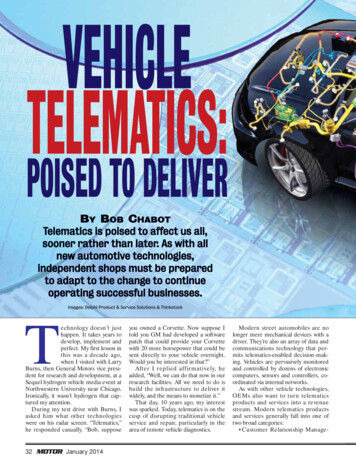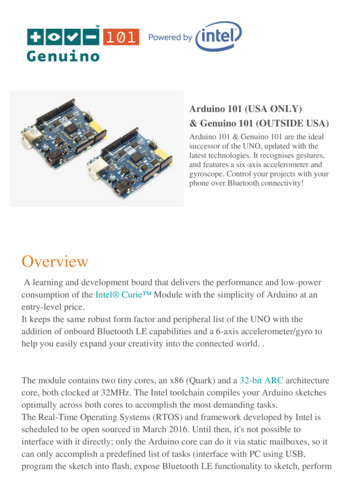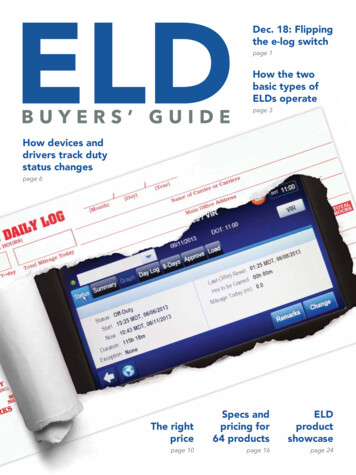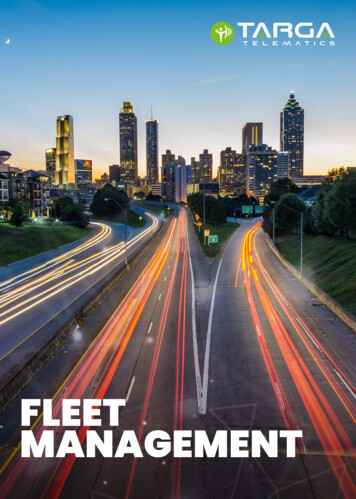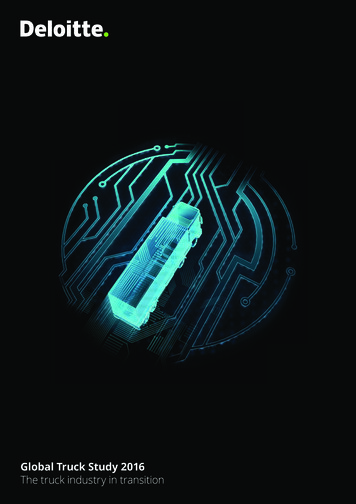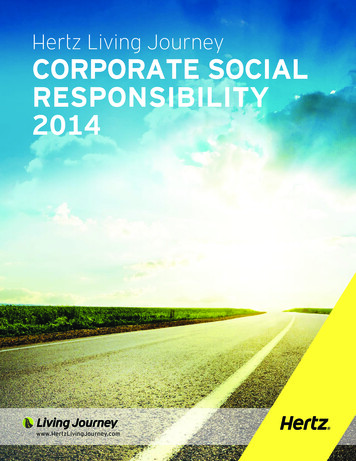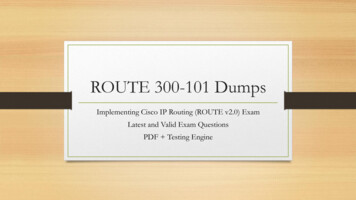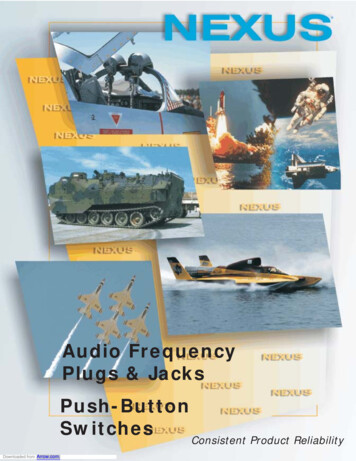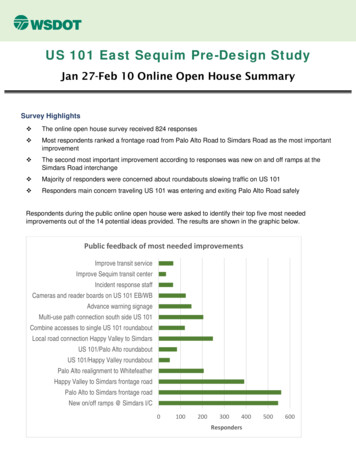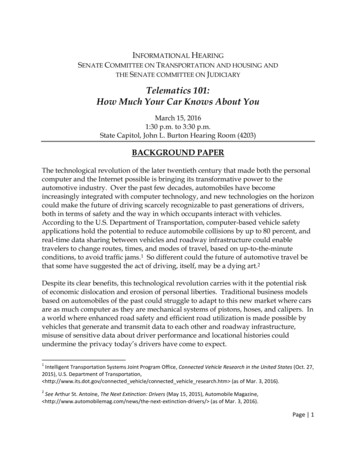
Transcription
INFORMATIONAL HEARINGSENATE COMMITTEE ON TRANSPORTATION AND HOUSING ANDTHE SENATE COMMITTEE ON JUDICIARYTelematics 101:How Much Your Car Knows About YouMarch 15, 20161:30 p.m. to 3:30 p.m.State Capitol, John L. Burton Hearing Room (4203)BACKGROUND PAPERThe technological revolution of the later twentieth century that made both the personalcomputer and the Internet possible is bringing its transformative power to theautomotive industry. Over the past few decades, automobiles have becomeincreasingly integrated with computer technology, and new technologies on the horizoncould make the future of driving scarcely recognizable to past generations of drivers,both in terms of safety and the way in which occupants interact with vehicles.According to the U.S. Department of Transportation, computer-based vehicle safetyapplications hold the potential to reduce automobile collisions by up to 80 percent, andreal-time data sharing between vehicles and roadway infrastructure could enabletravelers to change routes, times, and modes of travel, based on up-to-the-minuteconditions, to avoid traffic jams.1 So different could the future of automotive travel bethat some have suggested the act of driving, itself, may be a dying art.2Despite its clear benefits, this technological revolution carries with it the potential riskof economic dislocation and erosion of personal liberties. Traditional business modelsbased on automobiles of the past could struggle to adapt to this new market where carsare as much computer as they are mechanical systems of pistons, hoses, and calipers. Ina world where enhanced road safety and efficient road utilization is made possible byvehicles that generate and transmit data to each other and roadway infrastructure,misuse of sensitive data about driver performance and locational histories couldundermine the privacy today’s drivers have come to expect.1Intelligent Transportation Systems Joint Program Office, Connected Vehicle Research in the United States (Oct. 27,2015), U.S. Department of Transportation, http://www.its.dot.gov/connected vehicle/connected vehicle research.htm (as of Mar. 3, 2016).2See Arthur St. Antoine, The Next Extinction: Drivers (May 15, 2015), Automobile Magazine, ion-drivers/ (as of Mar. 3, 2016).Page 1
This joint hearing will explore how today’s connected cars operate, what the future ofautomobile technology looks like, and the choices policymakers may be confrontedwith as these technologies become more widely deployed.Overview of TelematicsThe terms “telematics” and “connected car technology” refer broadly to those groups oftechnologies that collect and transmit useful data to and from an automobile.Definitions of these terms vary – some stakeholders include telecommunicationsdevices like mobile phones connected to an automobile within the scope of telematics,while others would limit the definition to include only vehicle-based systems thatprovide specific services to drivers, like on-board navigation systems. Despite thesedifferences, all uses of these terms seem to include the following commonalities: (1) oneor more sensors that detect input from a vehicle, its components, or its occupants; (2) anon-board computing platform that transforms those inputs into useful data; and (3) acommunications platform that enables the transmission of data to and from the vehicle.During this hearing, we will hear testimony from a range of experts on what terms like“telematics” and “connected car technology” mean, and how useful distinctions can bemade between different systems broadly grouped into this field.The origin of modern telematics systems can be traced back to on-board diagnosticfeatures added to vehicles beginning in the early 1980s. These early systems collectedand analyzed data pertaining to vehicle performance and technical faults, but hadlimited capacities to transmit this data outside of the vehicle. Beginning with theadoption of second-generation on-board diagnostics (OBD-II) systems in the mid 1990’s,more vehicle performance data, including emissions data, became accessible viaimproved transmission channels to end users outside of an automobile. Thedeployment of both Global Positioning Satellite (GPS) systems and wireless telephonesystems in major metropolitan areas enabled General Motors (GM) to develop one ofthe first true telematics systems in 1996 – OnStar. This system, through a suite ofsensors, telephone and satellite communications channels, and user interfaces, had thecapacity to automatically detect vehicle collisions and summon emergency assistancewithout the need for user input. Using data gathered from GPS satellites and on-boardsensors, OnStar systems could transmit vehicle location data in the event of a collisionvia an on-board mobile phone unit to an OnStar monitoring facility, whose employeeswould then alert emergency response personnel with pertinent information about thecollision. This capacity enabled first responders to quickly learn of an accident evenwhen the occupants of a vehicle were unconscious and unable to summon help on theirown, provided the system could communicate with the monitoring facility.Modern telematics systems have built upon technology pioneered by GM and OnStar,allowing today’s vehicles to collect and use (or transmit) more data to enable additionalPage 2
features. Features available on modern telematics systems include vehicle and trailertracking for fleet management or the recovery of stolen vehicles, satellite navigation andreal-time traffic routing, mobile data connectivity that enables occupants to placetelephone calls or use the internet, and remote vehicle diagnostic services. Participantsin this joint hearing will describe some of the new features and capabilities of moderntelematics systems, and present an overview of what future telematics systems mightoffer.Policy PerspectivesAutomobile telematics systems present a number of potential issues that policymakerswill have to weigh as these systems become more sophisticated and widespread. Thefollowing topics highlight some of the policy related issues that witnesses at this jointhearing will address.I.Safety Improvements and Remote AssistanceThe possibility of significant improvement in vehicle and roadway safety is one of themost promising potentialities of telematics systems. According to the U.S. Departmentof Transportation (DOT), in 2009, there were 5.5 million crashes, almost 34,000 fatalities,and 2.2 million injuries on U.S. roads as a result of vehicle crashes. Telematics systemsand connected car applications could, according to DOT, reduce the occurrence of theseaccidents by upwards of 80 percent.3 Many of these systems work by using vehicle-tovehicle (V2V) and vehicle-to-infrastructure (V2I) communications to increase a driver’ssituational awareness of roadway hazards or to avoid collisions through enhanceddriving systems like automated braking. In general, V2V communications allowvehicles to be continuously aware of each other, relying on data sharing among nearbyvehicles to warn drivers about potentially dangerous situations that could lead to acrash, like the fact that an obscured vehicle ahead is rapidly breaking or that multiplevehicles are simultaneously approaching a blind intersection. V2I communicationsbetween a vehicle and roadway infrastructure similarly help prevent collisions throughin-car driver advisories and warnings, and infrastructure controls. For example, V2Isystems could alert a driver that they are about to veer off the edge of a roadway, oroptimize the timing of roadway signals to provide clear routes for emergency vehicles.Several technology companies and traditional automobile manufacturers have alsobegun development of driverless or fully automated vehicles. Like vehicles equippedwith V2V and V2I-based driver augmentation systems, autonomous vehicles rely on a3Intelligent Transportation Systems Joint Program Office, Connected Vehicle Research in the United States (Oct. 27,2015), U.S. Department of Transportation, http://www.its.dot.gov/connected vehicle/connected vehicle research.htm (as of Mar. 3, 2016).Page 3
series of external and internal sensors, computer processors, and telecommunicationssystems to operate safely in their environment. By eliminating the possibility ofcollisions due to human error – which is the underlying cause of most accidents –autonomous vehicles could greatly improve roadway safety for both vehicle occupantsand pedestrians. However, a number of technological and policy issues need to beresolved before autonomous vehicles are widely deployed on roadways, includingquestions on liability should an accident occur while a vehicle is operating inautonomous mode.Additionally, several automobile manufacturers and aftermarket providers aredeveloping, or have already developed, sophisticated automated crash responsesystems similar to OnStar. One such product sold by Verizon allows automobileowners to add telematics functionality to their cars that will automatically alert firstresponders in the event of a collision or help route roadside assistance to a disabledvehicle using GPS position data.4II.Enhanced In-Car FeaturesAside from safety improvements, many telematics systems offer advanced conveniencefeatures for drivers and vehicle occupants, like hands-free calling or on-demandconcierge services. Some of these products, like the one sold by Verizon, use imbeddedGPS sensors to help owners locate stolen vehicles, or receive turn-by-turn directions.Others, like GM’s most recent iteration of OnStar, allow vehicle owners to remotelyunlock or start their vehicles through the use of an on-board mobile telephoneconnection, or receive reminders about routine maintenance or vehicle health throughwireless transmission of vehicle performance and mileage data to analytic computersystems operated by OnStar.III.Fleet Management and Regulatory ComplianceTelematics products on the market today allow operators of commercial fleets thefunctionality to monitor the movements of their vehicles and the driving habits of theiremployees. One such product sold by TomTom Telematics allows fleet managers tomonitor driving behavior, fuel consumption, and GPS location in real time, equippingbusiness owners with tools to potentially reduce fleet travel times, mileage, andconsumption levels.5 Similarly, automobile manufacturers can collect and aggregateperformance data supplied by vehicle telematics systems to conduct research on theperformance of their vehicle fleets and detect regulatory compliance issues, likecommon vehicle system failures, that warrant issuance of a safety recall.4See https://www.hum.com/features.aspx5See http://business.tomtom.com/en us/Page 4
IV.Traffic Management and Environmental PerformanceAccording to the U.S. Department of Transportation, traffic congestion costs the U.S.economy an estimated 87.2 billion per year, with 4.2 billion hours and 2.8 billiongallons of fuel spent by drivers sitting in traffic.6 Telematics systems like V2I and onboard data transmission devices can collect and transmit traffic performance data totransportation agencies, allowing them to manage transportation systems for maximumefficiency and minimum congestion. These systems could also be used to capture andtransmit data related to a vehicle’s environmental performance to manufacturers andregulatory agencies, allowing for the monitoring of fleet-level environmentalperformance in real world conditions, and providing policymakers with data that couldbe used to inform environmentally responsible transportation planning.V.Privacy and CybersecurityDespite the many benefits telematics systems offer to both consumers andpolicymakers, the amount of data collected by these systems and the sensitivity of thisdata could, if improperly managed, undermine the privacy interests of Californiaresidents. Using large datasets gathered over time by a telematics system, it may bepossible to reconstruct the locational history of a vehicle and extrapolate certain detailsabout the car’s driver, including their “political and religious beliefs, sexual habits, andso on.”7 Information about driving habits and patterns could prove valuable tocommercial firms, and the unrestricted use or sale of this data may result in unwantedsolicitation or adverse commercial decisions. Data handling practices vary amongparties who receive information from telematics systems, and industry standards havenot yet emerged on matters such as data sharing and selling, data retention, data useand access, or consumer choice over the collection and use of telematics data. Withoutsufficient safeguards, telematics data collection and handling practices couldundermine the fundamental right of privacy guaranteed in Article I, Section 1, of theCalifornia Constitution.Similarly, insufficient telematics data and system security practices may underminepublic safety and the safety of passengers in telematics-equipped vehicles. Recentresearch has demonstrated that computer hackers may be able to seize control of avehicle through its telematics system, allowing them to remotely operate steering6Intelligent Transportation Systems Joint Program Office, Connected Vehicle Research in the United States (Oct. 27,2015), U.S. Department of Transportation, http://www.its.dot.gov/connected vehicle/connected vehicle research.htm (as of Mar. 3, 2016).7See United States v. Jones (2012) 132 S. Ct. 945, 955-956.Page 5
controls, brakes, and other critical safety systems.8 Deliberate, targeted attacks againsttelematics-equipped vehicles, especially those traveling at high rates of speed, couldhave disastrous consequences. If similar vulnerabilities were to emerge in futureconnected highway infrastructure, such as systems that regulate the flow of traffic forautonomous or semi-autonomous vehicles, the public safety threat to vehicle occupantsand nearby pedestrians could be significant.VI.Consumer Choice and Right to RepairTelematics systems offer consumers and automotive repair professionals real-timeaccess to extensive data about a vehicle’s performance. Access to such data and theability to fine-tune software algorithms running a vehicle’s systems may, in the nearfuture, become just as important as a traditional mechanic’s diagnostic and technicalabilities. As with data handling practices, industry standards governing access to thisimportant data source have not yet emerged. Consumer choice concerning wherevehicle repair services are obtained could be imperiled if access to data generated by avehicle’s on-board computer system is unduly restricted to specific parties, and lack ofaccess to real-time performance data could result in the diversion of business to thoseselected by the party in control of a vehicle’s telematics data stream. Unduly restrictivepractices could significantly impact small businesses left without access to telematicsdata and could result in economic dislocation within California’s automotive repairindustry.ConclusionTelematics systems offer a number of benefits that could greatly improve the safety andefficiency of California’s roads and highways. However, without proper standards andresponsible practices, this new technology could undermine public safety, privacy, andeconomic well-being. This hearing will help acquaint policymakers with howtelematics systems operate, as well as with some of the policy issues raised by their use.8See Andy Greenberg, Hackers Remotely Kill a Jeep on the Highway—With Me in It (Jul. 21, 2015), Wired Magazine -jeep-highway/ (as of Mar. 11, 2016).Page 6
begun development of driverless or fully automated vehicles. Like vehicles equipped with V2V and V2I-based driver augmentation systems, autonomous vehicles rely on a 3 Intelligent Transportation Systems Joint Program Office, Connected Vehicle Research in the United States (Oct. 27, 2015), U.S. Department of Transportation,



